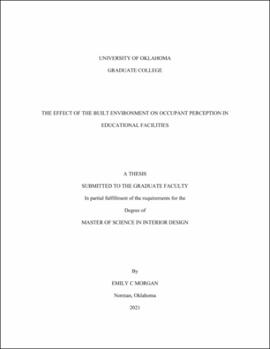| dc.description.abstract | Understanding how the built environment can influence occupant’s mental health is critical when designing buildings. This is especially importance for building where users will spend up to seven hours of their time every day (Sparks, 2020). Adolescent aged students have rapidly increasing rates of declining mental health. Blakemore (2018) talks about how many people discredit the adolescent when in reality the adolescent stage is one of the most formative time for brain development. Understanding how an educational environmental setting can influence the mental health of its adolescent occupants is of prime importance to the prevent future onset of depression or mental illness.
As indicated in by Dannenberg et al. (2011) in Making Healthy Places mental health can be defined as “A state of well-being in which the individual realizes his or her own potential, can cope with the normal stresses of life, can work productively and fruitfully, and is able to make a contribution to her or his community,” (Dannenberg et al., 2011, p. 387). A research gap analysis was conducted to identify the problem associated with environmental influence on mental health of indoor occupants that has not been addressed adequately in past literature. This goal of this study is to analyze the influence of indoor environmental parameters, such as color, light, and connection to nature on an adolescent’s mental health in an educational setting. The study will identify ways for designers to create the feeling and attachment of place for occupants within an educational setting. Giving the students a chance to develop a relationship with the building should help with creating a healthy and productive environment.
This qualitative research study has adopted mixed methods of surveys, interviews, and case study analysis. The data collection method started with a survey of recent high school graduates. Upon the completion of the initial survey, the study focused on a one-on-one interview with a designer from the renovated case study. A case study analysis was performed to study the high school building that went through an indoor environmental upgrade as indicated by the interview participants. A further look into the environments lead to design suggestions that could improve the environment towards creating positive influences on mental health. | en_US |
